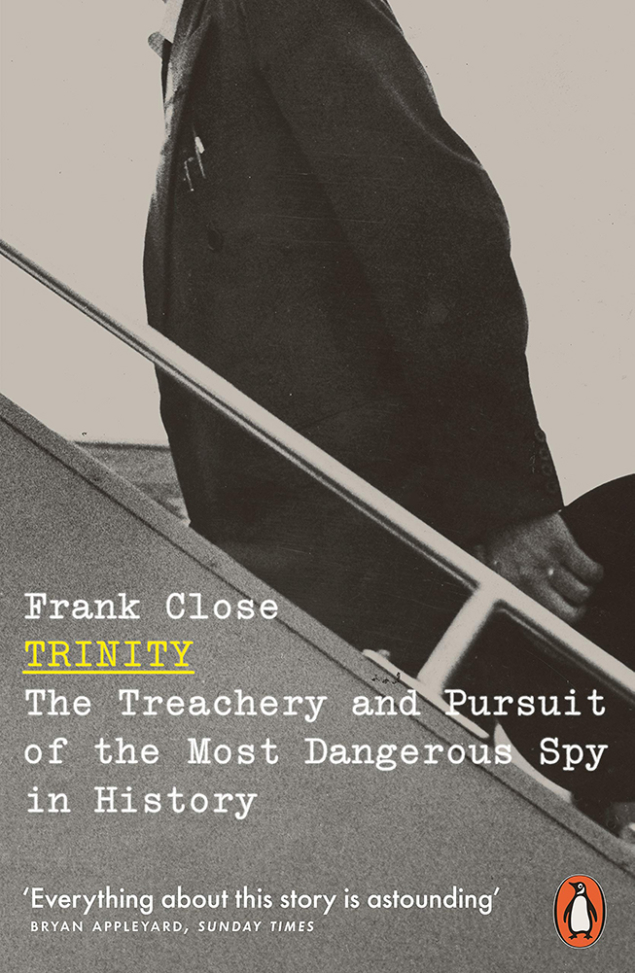Trinity: The Treachery and Pursuit of the Most Dangerous Spy in History, By Frank Close, Penguin

“Why do you give all those secrets to the Russians?” So teases an inebriated Mary Bunemann, confidante to the leading nuclear physicists at the UK’s Atomic Energy Research Establishment, at the emotional climax of Frank Close’s new book Trinity: The Treachery and Pursuit of the Most Dangerous Spy in History. The scene is a party on New Year’s Eve in 1949, in the cloistered laboratory at Harwell, in the Berkshire countryside. With her voice audible across a room populated by his close colleagues and friends, Bunemann unwittingly confronted theoretical physicist Klaus Fuchs with the truth of his double life. As Close’s text suspensefully unfolds, the biggest brain working on Britain’s effort to build a nuclear arsenal had been faced with the very same allegation by an MI5 interrogator just 10 days earlier.
Close’s story expands dramatically in scope when Peierls and Fuchs are recruited to the Manhattan Project
Klaus Fuchs began working on nuclear weapons in 1941, when he was recruited by Rudolf Peierls – the “midwife to the atomic age”, in Close’s estimation. Both men were refugees from Nazi Germany. A few years older, and better established in Britain, Peierls would become a friend and mentor to Fuchs. A quarter of a century later, Peierls would also establish a relationship with a young Frank Close, when he arrived at Oxford’s theoretical physics department. Close has now been able to make a poignant contribution to the literature of the bomb by sharing the witness of his connection to the Peierls family, who felt Fuchs’ betrayal bitterly, and were personally affected by the suspicion engendered by his espionage.
Close’s story expands dramatically in scope when Peierls and Fuchs are recruited to the Manhattan Project. Though Peierls was among the first to glimpse the power of atomic weapons, Fuchs began to exceed him in significance to the project during this period. In one of the strongest portions of the book, Close balances physics, politics and the intrigue of shady meetings with Fuchs’ handlers at a time when he passed to the Soviet Union a complete set of instructions for building the first stage of a uranium bomb, a full description of the plutonium bomb used in the Trinity test in the New Mexico desert, and detailed notes on Enrico Fermi’s lectures on the hydrogen bomb.
Intensely claustrophobic
The story becomes intensely claustrophobic when Fuchs returns to England to head the theoretical physics department at Harwell. Here, Close evokes the contradictions in Fuchs’ character: his conviction that nuclear knowledge should be shared between great powers to avert war; his principled but tested faith in communism, awakened while protesting the rise of Nazism; his devoted pastoral care for members of his inner circle at Harwell, even as the net closed around him; and his willingness to share not only nuclear secrets but also the bed of his colleague’s wife. Close has a particular obsession with the question of whether Fuchs’ eventual confession was induced by unrealistic suggestions that he could be forgiven and continue his work. But inducement did not jeopardise Fuchs’ ultimate conviction and imprisonment, despite MI5’s fears, and Close judges his 14-year sentence, later reduced, to be just. Even here, however, the Soviets had the last laugh, with Fuchs’ apprehension not only depriving the British nuclear programme of its greatest intellectual asset, but also precipitating the defection of Bruno Pontecorvo.

Close chose an ideal moment to research his history, writing with the benefit of newly released MI5 records, and before several others were withdrawn without notice. He applies forensic attention to the agency’s pursuit of the nuclear spy. Occasionally, however, this is to the detriment of the reader, with events seemingly diffracted onto the pages – both prefigured and returned to as the story progresses and new evidence comes to light. We step through time in Fuchs’ shoes, for example only learning at the end of the book that two other spies at the Manhattan Project were also passing information to the Russians. While Close’s inclination to let the evidence speak for itself is surely the mark of a good physicist, readers in search of a more analytical history may wish to also consult Mike Rossiter’s 2014 biography The Spy Who Changed the World: Klaus Fuchs and the secrets of the nuclear bomb, which offers a more rounded presentation of the Russian and American perspectives.
By bringing physics expertise, personal connections and impressive attention to detail to bear, Frank Close’s latest book has much to offer readers seeking insights into a formative time for the field, when the most talented minds in nuclear physics also bore the weight of world politics on their shoulders. He eloquently tells the tragedy of “the most dangerous spy in history”, as it played out between the trinity of Fuchs, his mentor Peierls and a shadowy network of spooks. Above all, the text is an intimate portrait of the inner struggles of a principled man who betrayed his adopted homeland, even as he grew to love it, and by doing so helped to shape the latter half of the 20th century.








